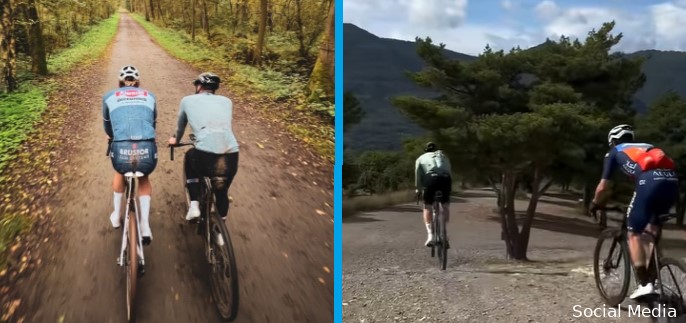Report: Cycling’s Changing Landscape: Van der Poel Embraces Gravel While Pogacar Hints at 2025 Ambitions….
As the cycling season progresses, the sport continues to evolve, with elite riders exploring new terrains and challenges. Recently, two of the biggest names in cycling—Mathieu van der Poel and Tadej Pogacar—have sparked conversation among fans and analysts alike regarding the future direction of their careers. Van der Poel has already made the switch to gravel racing, while Pogacar appears to be subtly signaling his ambitions for 2025. This article delves into the implications of these developments, the motivations behind them, and what they mean for the future of professional cycling.
Mathieu van der Poel has long been regarded as one of the most versatile riders in the sport. Known for his explosive power and tactical acumen, Van der Poel has excelled across various disciplines, from cyclo-cross to road racing and mountain biking. His recent foray into gravel racing is a testament to his adaptability and willingness to embrace new challenges.
Gravel racing has exploded in popularity over the past few years, attracting not only amateur cyclists but also professional athletes seeking new avenues for competition. Van der Poel’s decision to compete in prominent gravel events has not only drawn attention to the discipline but also raised questions about the future of traditional road racing. His performances have been nothing short of spectacular, often showcasing his unique ability to navigate diverse terrains with ease.
Van der Poel’s move is significant for several reasons. First, it highlights a growing trend among professional cyclists to explore gravel racing as a legitimate discipline rather than a mere side venture. The appeal of gravel lies in its adventurous spirit, the opportunity to race in scenic locations, and the ability to connect with a wider cycling community. As more elite cyclists venture into this space, the dynamics of competitive cycling could shift.
Moreover, Van der Poel’s success in gravel events could inspire a new generation of riders who may prioritize off-road challenges over traditional road racing. This could lead to a more diverse and multifaceted cycling landscape, as riders begin to view gravel events as viable career paths rather than secondary pursuits.
In contrast to Van der Poel’s immediate transition to gravel, Tadej Pogacar’s recent comments suggest a more long-term vision. The Slovenian superstar has dominated the road racing scene, winning multiple Grand Tours and establishing himself as a household name. However, his recent hints about ambitions for 2025 have piqued interest among fans and pundits alike.
Pogacar’s comments, though not explicitly detailed, suggest he is considering his future in the sport and the potential for new challenges. Speculation has arisen about whether he might seek to compete in gravel events, especially given the increasing crossover between disciplines. As he contemplates the next phase of his career, Pogacar’s thoughts about 2025 could signify a strategic shift in his approach to racing.
While Pogacar has excelled in stage races, the allure of gravel racing and its unstructured, exploratory nature could appeal to him. As a rider who thrives in challenging environments, the prospect of gravel racing may offer Pogacar a refreshing change of pace, allowing him to showcase his versatility outside the confines of traditional road racing
The growing popularity of gravel racing has raised important questions about the future of road cycling. As riders like Van der Poel embrace this new terrain, the sport is witnessing a shift in its competitive landscape. This intersection of gravel and road racing reflects broader trends in cycling, where athletes seek variety and new experiences.
Many professional cyclists are now considering gravel events as part of their overall racing strategy. The ability to compete in different formats not only broadens their skill sets but also engages fans in novel ways. This shift could lead to a diversification of the racing calendar, with more riders participating in both gravel and road events, thereby enriching the sport.
Gravel races often emphasize endurance and tactical acumen, requiring riders to adapt to varying conditions and terrain. This mirrors the challenges faced in road racing but adds an additional layer of complexity. As more elite cyclists participate in gravel events, the level of competition is likely to rise, making it an even more appealing format for both athletes and spectators.
As Van der Poel and Pogacar navigate their respective paths, the cycling community is left to ponder the implications for the sport as a whole. The move toward gravel racing could usher in a new era of cycling, one that values versatility and adaptability among its athletes. This transition may also attract a broader audience, drawing in those who appreciate the adventurous spirit of gravel racing.
For young riders, the examples set by Van der Poel and Pogacar offer a blueprint for a more diverse career trajectory. The potential to pursue various formats within cycling could inspire a new generation to explore different disciplines and expand their horizons.
As Pogacar hints at ambitions for 2025, the focus on long-term planning in a rapidly evolving sport becomes evident. Athletes must navigate their careers strategically, balancing the demands of traditional road racing with the opportunities presented by emerging disciplines like gravel racing.
Fans of cycling are reacting positively to the developments surrounding Van der Poel and Pogacar. Many appreciate the versatility and adaptability shown by these athletes, viewing it as a reflection of the sport’s evolution. The idea of elite riders competing in gravel races is seen as an exciting prospect, one that could breathe new life into the cycling calendar.
From a marketing perspective, the growing interest in gravel racing presents opportunities for sponsors and event organizers. With prominent riders like Van der Poel leading the charge, gravel events are likely to see increased attendance and viewership, boosting their profile in the competitive cycling landscape.
For cycling teams, the diversification of racing formats may require a reevaluation of training and development strategies. Teams may need to invest in specialized equipment and support staff capable of addressing the unique challenges posed by gravel racing. This shift could lead to a more holistic approach to athlete development, one that prepares riders for a range of competitive environments.
The trajectories of Mathieu van der Poel and Tadej Pogacar signal an exciting time for professional cycling. Van der Poel’s transition to gravel racing and Pogacar’s hints about 2025 reflect a broader shift within the sport, as athletes seek new challenges and opportunities. As gravel racing continues to gain momentum, it is likely to reshape the competitive landscape, offering a fresh perspective on what it means to be a professional cyclist.
The future of cycling appears to be one marked by versatility and adaptability, where elite athletes embrace a range of formats and challenges. For fans, this evolution promises an exciting array of events and competitions to follow, showcasing the talents of riders who are willing to explore new frontiers in the sport. Whether through the grit of gravel racing or the intensity of road racing, the cycling world is set for a thrilling ride ahead.


